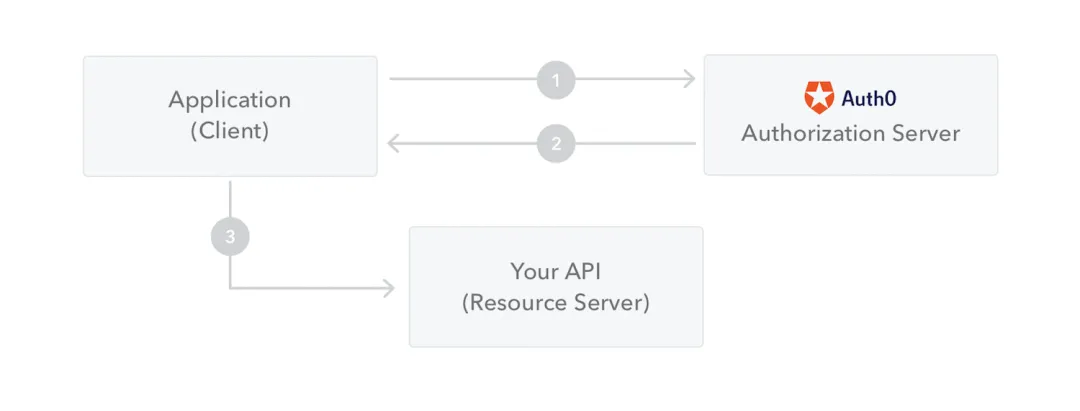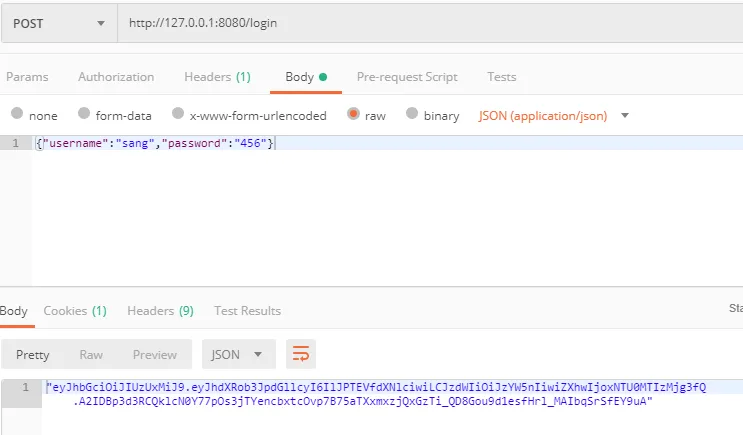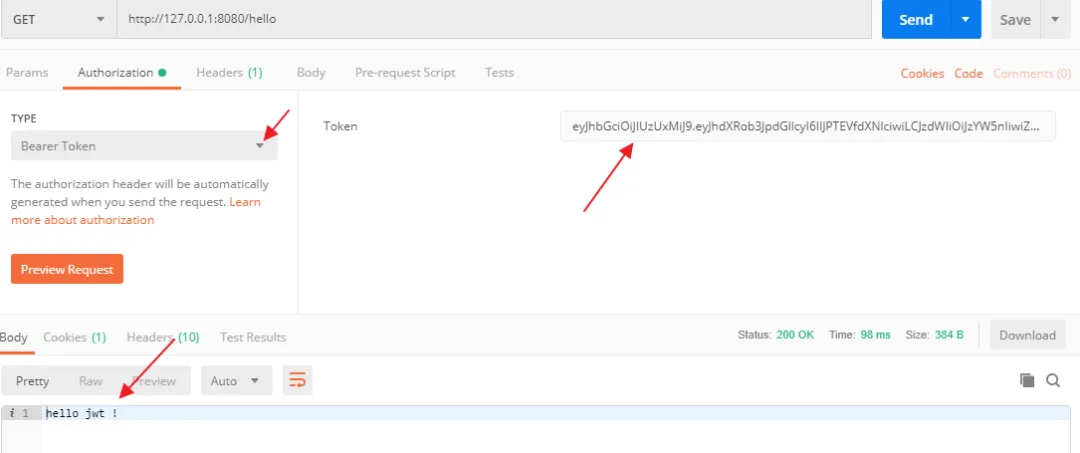一 无状态登录
1.1 什么是有状态
有状态服务,即服务端需要记录每次会话的客户端信息,从而识别客户端身份,根据用户身份进行请求的处理,典型的设计如 Tomcat 中的 Session。例如登录:用户登录后,我们把用户的信息保存在服务端 session 中,并且给用户一个 cookie 值,记录对应的 session,然后下次请求,用户携带 cookie 值来(这一步有浏览器自动完成),我们就能识别到对应 session,从而找到用户的信息。这种方式目前来看最方便,但是也有一些缺陷,如下:
- 服务端保存大量数据,增加服务端压力
- 服务端保存用户状态,不支持集群化部署
1.2 什么是无状态
微服务集群中的每个服务,对外提供的都使用 RESTful 风格的接口。而 RESTful 风格的一个最重要的规范就是:服务的无状态性,即:
- 服务端不保存任何客户端请求者信息
- 客户端的每次请求必须具备自描述信息,通过这些信息识别客户端身份
那么这种无状态性有哪些好处呢?
- 客户端请求不依赖服务端的信息,多次请求不需要必须访问到同一台服务器
- 服务端的集群和状态对客户端透明
- 服务端可以任意的迁移和伸缩(可以方便的进行集群化部署)
- 减小服务端存储压力
1.3 如何实现无状态
无状态登录的流程:
- 首先客户端发送账户名/密码到服务端进行认证
- 认证通过后,服务端将用户信息加密并且编码成一个 token(一般是 JWT),返回给客户端
- 以后客户端每次发送请求,都需要携带认证的 token
- 服务端对客户端发送来的 token 进行解密,判断是否有效,并且获取用户登录信息
二 JWT
2.1 JWT 简介
JWT,全称是 Json Web Token, 是一种 JSON 风格的轻量级的授权和身份认证规范,可实现无状态、分布式的 Web 应用授权:
 图片
图片
JWT 作为一种规范,并没有和某一种语言绑定在一起,常用的 Java 实现是 GitHub 上的开源项目 jjwt,地址如下:https://github.com/jwtk/jjwt
2.2 JWT 数据格式
JWT 包含三部分数据:
- Header:头部,通常头部有两部分信息:
声明类型,这里是JWT
加密算法,自定义
我们会对头部进行 Base64Url 编码(可解码),得到第一部分数据。
- Payload:载荷,就是有效数据,在官方文档中(RFC7519),这里给了7个示例信息:
iss (issuer):表示签发人
exp (expiration time):表示token过期时间
sub (subject):主题
aud (audience):受众
nbf (Not Before):生效时间
iat (Issued At):签发时间
jti (JWT ID):编号
这部分也会采用 Base64Url 编码,得到第二部分数据。
- Signature:签名,是整个数据的认证信息。一般根据前两步的数据,再加上服务的的密钥secret(密钥保存在服务端,不能泄露给客户端),通过 Header 中配置的加密算法生成。用于验证整个数据完整和可靠性。
生成的数据格式如下图:
 图片
图片
注意,这里的数据通过 . 隔开成了三部分,分别对应前面提到的三部分,另外,这里数据是不换行的,图片换行只是为了展示方便而已。
2.3 JWT 交互流程
流程图:
 图片
图片
步骤翻译:
- 应用程序或客户端向授权服务器请求授权
- 获取到授权后,授权服务器会向应用程序返回访问令牌
- 应用程序使用访问令牌来访问受保护资源(如 API)
因为 JWT 签发的 token 中已经包含了用户的身份信息,并且每次请求都会携带,这样服务的就无需保存用户信息,甚至无需去数据库查询,这样就完全符合了 RESTful 的无状态规范。
2.4 JWT 存在的问题
说了这么多,JWT 也不是天衣无缝,由客户端维护登录状态带来的一些问题在这里依然存在,举例如下:
- 续签问题,这是被很多人诟病的问题之一,传统的 cookie+session 的方案天然的支持续签,但是 jwt 由于服务端不保存用户状态,因此很难完美解决续签问题,如果引入 redis,虽然可以解决问题,但是 jwt 也变得不伦不类了。
- 注销问题,由于服务端不再保存用户信息,所以一般可以通过修改 secret 来实现注销,服务端 secret 修改后,已经颁发的未过期的 token 就会认证失败,进而实现注销,不过毕竟没有传统的注销方便。
- 密码重置,密码重置后,原本的 token 依然可以访问系统,这时候也需要强制修改 secret。
- 基于第 2 点和第 3 点,一般建议不同用户取不同 secret。
对于上面提到的这些问题,在目前具体的项目实践中,更多的是通过引入 Redis 来解决这些问题。
三 实战
说了这么久,接下来我们就来看看这个东西到底要怎么用?
3.1 环境搭建
首先我们来创建一个 Spring Boot 项目,创建时需要添加 Spring Security 依赖,创建完成后,添加 jjwt 依赖,完整的 pom.xml 文件如下:
<dependency>
<groupId>org.springframework.boot</groupId>
<artifactId>spring-boot-starter-security</artifactId>
</dependency>
<dependency>
<groupId>org.springframework.boot</groupId>
<artifactId>spring-boot-starter-web</artifactId>
</dependency>
<dependency>
<groupId>io.jsonwebtoken</groupId>
<artifactId>jjwt</artifactId>
</dependency>然后在项目中创建一个简单的 User 对象实现 UserDetails 接口,如下:
public class User implements UserDetails {
private String username;
private String password;
private List<GrantedAuthority> authorities;
public String getUsername() {
return username;
}
@Override
public boolean isAccountNonExpired() {
return true;
}
@Override
public boolean isAccountNonLocked() {
return true;
}
@Override
public boolean isCredentialsNonExpired() {
return true;
}
@Override
public boolean isEnabled() {
return true;
}
//省略getter/setter
}这个就是我们的用户对象,先放着备用,再创建一个 HelloController,内容如下:
@RestController
public class HelloController {
@GetMapping("/hello")
public String hello() {
return "hello jwt !";
}
@GetMapping("/admin")
public String admin() {
return "hello admin !";
}
}HelloController 很简单,这里有两个接口,设计是 /hello 接口可以被具有 user 角色的用户访问,而 /admin 接口则可以被具有 admin 角色的用户访问。
3.2 JWT 配置
先准备一个 JWT 操作的工具类:
public class JwtUtils {
public static final Integer EXPIRE_TIME = 7 * 24 * 60 * 60;
public static final Integer REDIS_TOKEN_EXPIRE_TIME = 30 * 60;
public static final String TOKEN_ISSUER = "javaboy";
/**
* 生成 JWT 字符串
*
* @return
*/
public static String createJWT() throws IOException, NoSuchAlgorithmException, InvalidKeySpecException {
Authentication authentication = SecurityContextHolder.getContext().getAuthentication();
String jws = Jwts.builder()
//设置头部信息(相当于 JWT 字符串第一部分的内容)
.header().add("type", "JWT")
.and()
//相当于 JWT 字符串第二部分的内容
//签名密钥
.signWith(getPrivateKey())
//设置过期时间
.expiration(java.util.Date.from(java.time.Instant.now().plusSeconds(EXPIRE_TIME)))
//设置用户名
.subject(authentication.getName())
//设置用户权限,相当于把用户权限转为字符串 admin,user,xxx
.claim("authorities", authentication.getAuthorities().stream().map(a -> a.getAuthority()).collect(Collectors.joining(",")))
//令牌签发时间
.issuedAt(new Date())
.issuer(TOKEN_ISSUER)
.compact();
return jws;
}
public static PrivateKey getPrivateKey() throws IOException, NoSuchAlgorithmException, InvalidKeySpecException {
ClassPathResource resource = new ClassPathResource("private_key.pem");
byte[] privateKeyBytes = FileCopyUtils.copyToByteArray(resource.getInputStream());
String key = new String(privateKeyBytes, StandardCharsets.UTF_8);
String privateStr = key
.replace("-----BEGIN PRIVATE KEY-----", "")
.replaceAll(System.lineSeparator(), "")
.replace("-----END PRIVATE KEY-----", "");
byte[] privateKeyDecodedBytes = Base64.getDecoder().decode(privateStr);
PKCS8EncodedKeySpec keySpec = new PKCS8EncodedKeySpec(privateKeyDecodedBytes);
KeyFactory keyFactory = KeyFactory.getInstance("RSA");
PrivateKey privateKey = keyFactory.generatePrivate(keySpec);
return privateKey;
}
public static RSAPublicKey getPublicKey() throws IOException, NoSuchAlgorithmException, InvalidKeySpecException {
ClassPathResource resource = new ClassPathResource("public_key.pem");
byte[] publicKeyBytes = FileCopyUtils.copyToByteArray(resource.getInputStream());
String key = new String(publicKeyBytes, StandardCharsets.UTF_8);
String publicStr = key
.replace("-----BEGIN PUBLIC KEY-----", "")
.replaceAll(System.lineSeparator(), "")
.replace("-----END PUBLIC KEY-----", "");
KeyFactory keyFactory = KeyFactory.getInstance("RSA");
byte[] publicKeyBase64Bytes = Base64.getDecoder().decode(publicStr);
X509EncodedKeySpec publicKeySpec = new X509EncodedKeySpec(publicKeyBase64Bytes);
PublicKey rsaPublicKey = keyFactory.generatePublic(publicKeySpec);
return (RSAPublicKey) rsaPublicKey;
}
public static Authentication verifyToken(String token) {
try {
Claims claims = Jwts.parser()
.verifyWith(getPublicKey()).build()
.parseSignedClaims(token).getPayload();
String username = claims.getSubject();
// user,admin,xxx
String authorities = claims.get("authorities", String.class);
// 解析用户权限
List<SimpleGrantedAuthority> list = Arrays.stream(authorities.split(",")).map(s -> new SimpleGrantedAuthority(s)).collect(Collectors.toList());
return UsernamePasswordAuthenticationToken.authenticated(username, null, list);
} catch (Exception e) {
//令牌校验失败
return null;
}
}
}接下来,在用户登录成功的时候,生成 JWT 字符串,并存入到 Redis 中,如下:
@Bean
SecurityFilterChain securityFilterChain(HttpSecurity http) throws Exception {
http.authorizeHttpRequests(a -> a.anyRequest().authenticated())
.csrf(c -> c.disable())
.sessionManagement(s -> s.sessionCreationPolicy(SessionCreationPolicy.STATELESS))
.formLogin(f -> f
.successHandler((req, resp, auth) -> {
//登录成功,生成 JWT 字符串
try {
String token = JwtUtils.createJWT();
//将 JWT 字符串保存到 redis 中
redisTemplate.opsForValue().set(auth.getName() + ":" + token, auth.getName());
// 设置过期时间
redisTemplate.expire(auth.getName() + ":" + token, JwtUtils.REDIS_TOKEN_EXPIRE_TIME, TimeUnit.SECONDS);
resp.setContentType("application/json;charset=utf-8");
RespBean respBean = new RespBean(200, token, null);
resp.getWriter().write(new ObjectMapper().writeValueAsString(respBean));
} catch (NoSuchAlgorithmException e) {
throw new RuntimeException(e);
} catch (InvalidKeySpecException e) {
throw new RuntimeException(e);
}
})
.permitAll())
.logout(l -> l.logoutSuccessHandler((req, resp, auth) -> {
// 删除 redis 中的 token
String key = auth.getName() + ":" + req.getHeader("Authorization").replace("Bearer ", "");
System.out.println("key = " + key);
redisTemplate.delete(key);
resp.getWriter().write("logout success");
}).logoutUrl("/logout").permitAll());
http.addFilterAfter(new JwtFilter(redisTemplate), SecurityContextHolderFilter.class);
return http.build();
}最后再来一个校验的过滤器,在用法发送请求的时候,校验 JWT 字符串,如下:
public class JwtFilter extends GenericFilterBean {
StringRedisTemplate redisTemplate;
public JwtFilter(StringRedisTemplate redisTemplate) {
this.redisTemplate = redisTemplate;
}
@Override
public void doFilter(ServletRequest servletRequest, ServletResponse servletResponse, FilterChain filterChain) {
RespBean result = null;
HttpServletRequest req = (HttpServletRequest) servletRequest;
HttpServletResponse resp = (HttpServletResponse) servletResponse;
resp.setContentType("application/json;charset=utf-8");
try {
//如果是登录请求,则直接放行
if (req.getRequestURI().equals("/login")) {
filterChain.doFilter(servletRequest, servletResponse);
return;
}
//获取请求头中的token
String token = req.getHeader("Authorization");
if (token == null) {
result = new RespBean(500, "令牌为空,请求失败", null);
PrintWriter out = resp.getWriter();
out.write(new ObjectMapper().writeValueAsString(result));
} else {
//验证token
token = token.replace("Bearer ", "");
//验证token是否有效
//校验通过,则返回认证后的 Auhtentication 对象,否则返回 null
Authentication authentication = JwtUtils.verifyToken(token);
String s = redisTemplate.opsForValue().get(authentication.getName() + ":" + token);
if (s == null) {
// 令牌失效
result = new RespBean(501, "令牌失效,请重新登录", null);
resp.getWriter().write(new ObjectMapper().writeValueAsString(result));
} else {
//令牌有效,检查令牌过期时间,如果临近过期,则为令牌续期
Long expire = redisTemplate.getExpire(authentication.getName() + ":" + token);
if (expire != null && expire < 10 * 60) {
//说明令牌还有 10 分钟过期,则重新设置新的过期时间
redisTemplate.expire(authentication.getName() + ":" + token, Duration.ofSeconds(JwtUtils.REDIS_TOKEN_EXPIRE_TIME));
}
SecurityContextHolder.getContext().setAuthentication(authentication);
filterChain.doFilter(servletRequest, servletResponse);
}
}
} catch (Exception e) {
} finally {
// 清除上下文
SecurityContextHolder.clearContext();
}
}
}关于这个过滤器,我说如下几点:
- 首先从请求头中提取出 Authorization 字段,这个字段对应的 value 就是用户的 token。
- 将提取出来的 token 字符串调用 JwtUtils.verifyToken 方法进行验证,将验证结果放到当前的 SecurityContext 中,然后执行过滤链使请求继续执行下去。
3.3 Spring Security 配置
最后,在 Spring Security 中配置这个过滤器。
http.addFilterAfter(new JwtFilter(redisTemplate), SecurityContextHolderFilter.class);搞定!
3.4 测试
做完这些之后,我们的环境就算完全搭建起来了,接下来启动项目然后在 POSTMAN 中进行测试,如下:
 图片
图片
登录成功后返回的字符串就是经过 base64url 转码的 token,一共有三部分,通过一个 . 隔开,我们可以对第一个 . 之前的字符串进行解码,即 Header,如下:
 图片
图片
再对两个 . 之间的字符解码,即 payload:
 图片
图片
可以看到,我们设置信息,由于 base64 并不是加密方案,只是一种编码方案,因此,不建议将敏感的用户信息放到 token 中。
接下来再去访问 /hello 接口,注意认证方式选择 Bearer Token,Token 值为刚刚获取到的值,如下:
 图片
图片
可以看到,访问成功。
四 总结
这就是 JWT 结合 Spring Security 的一个简单用法。







































